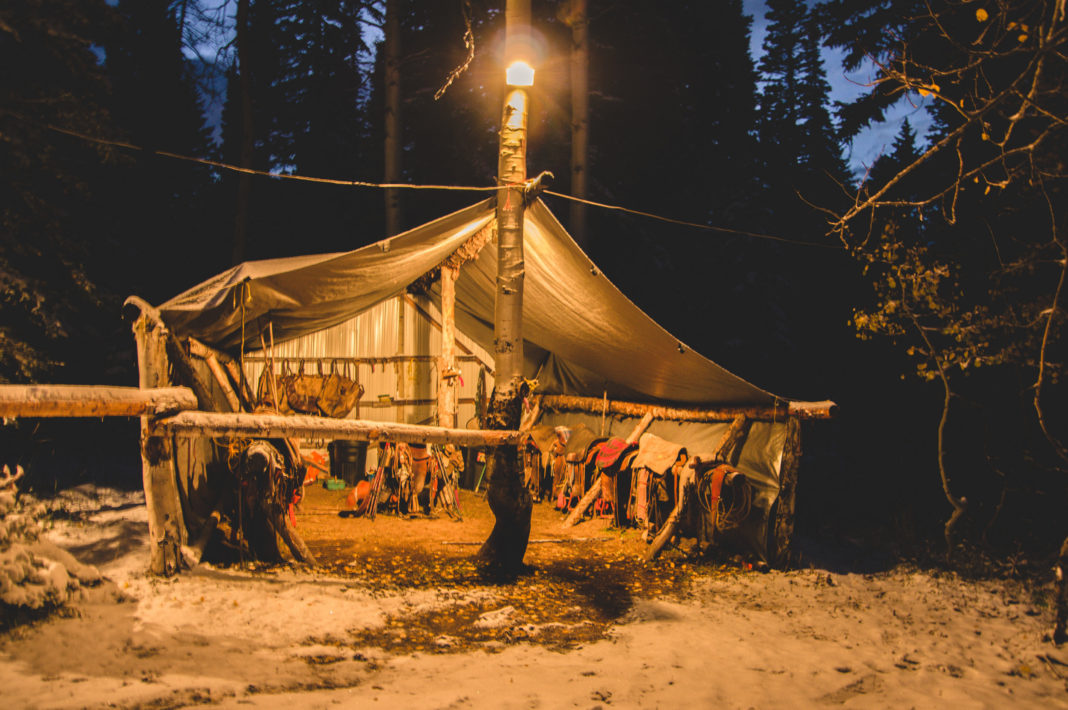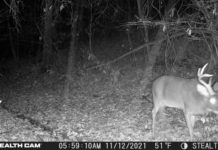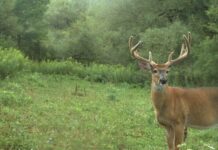Areas to hunt elk that are easy to gain access to usually receive a lot of hunting pressure. These places are normally public land, states where you can purchase a tag over the counter or areas with plenty of leftover tag being sold on a first come first serve basis. To kill a bull in one of these areas you are going to change your ways of thinking and hunting. A big bull is still within your grasp; just follow the steps outlined below. They will take you from preparing at home for the hunt to what to do when you kill a big bull.
GET IN SHAPE: The first thing that has to be done it to get in good enough physical shape for the demanding hunt. My exercise regiment involves long walks of 10 miles, 3 times a week that I start several months in advance of the hunt. While walking I wear a backpack filled with 30 pounds. I also wear the boots that I will be hunting in. Now is the time to get your boots in shape too. This might sound like a lot, but it does not compare to the physical demand of an elk hunt.
Many hunters come home from an elk hunt empty handed every year because they were not up for the challenge. They did just fine at sea level, but everything changes at 10,000 feet. Not only does the body fail many hunters, but also eventually their mental strength will be zapped if their body is not ready. The mind will be saying, “O.K., lets just stop, I know you don’t feel good.” It’s never too early to get in shape rather you are getting ready for a hunt or not. I believe this is to be the most important element of a successful hunt.
CHOOSE A STATE: Deciding where to hunt elk is a challenge all in itself. Every state has different regulations concerning their issuing of an elk permit. Some states allow tags to be sold over the counter, while other states issue permits through a lottery. Many states issue permits through a point system for the units with the highest demand and the biggest bulls. But, for the archer willing to work for it, it is very possible to kill a big bull in an area that will not require points or luck to be drawn for a tag. Know when the deadlines are to have an application postmarked by. Some states are as early as January.
PLAN ACCORDINGLY: It is important when planning your hunt to figure in enough days. A week of actual hunting could easily turn into a couple of weeks or more of being gone away from home and work. The time traveling to and from your hunting destination, time spent scouting before the hunt and if you happen to kill an elk towards the end of your hunt you need to plan a day or two for getting the animal off the mountain. All of this has to be taken into consideration when planning your trip.
PRACTICE: Practicing with your bow as often as you can is very important. Remember that you are not hunting whitetails where your shots will be limited to around 25 yards. Instead, you will be hunting in the wide-open west where your shots could be out to 50 yards, or even more. Bring a bow capable of killing an elk. Adjust your draw weight to a minimum of 65 pounds. Practice with your bow at this poundage, the extra draw weight could mean that you might have to re-sight your bow. Also, if you are not used to pulling this amount of weight you could notice some soreness in your muscles. Give yourself plenty of time to work out any kinks in your new bow set up, as well as your back.
Elk are big animals that can easily fray the nerves of even the most experienced elk hunter. Being able to be confident in your shooting abilities at longer ranges will help you tremendously in the moment of truth.
SCOUT: Unless you are the luckiest hunter in the world you will not kill a bull without good scouting. Scouting begins at home from the comfort of my recliner. Studying maps of the area I plan to hunt does this. These maps are available trough the USGS on the Internet, or can be bought at a BLM office.
The first thing I do is trace around the unit I will be hunting in. Next, I look for roads or trails that will give me access to where I will be hunting. It is important to know where pressured elk likely will go. I look at my map for areas with steep terrain, and north and east facing slopes. Slopes facing these two directions, compared to south and west facing slopes will have the thickest timber. I look for areas as far off the beaten path as I can. The majority of hunters will not travel more than one-half mile from the road. Elk will soon realize where all the hunters are grouped, and will travel further into the timber and up the mountains to avoid this disturbance. Look for areas at least 1 ½ miles from the road. You will have very few hunters to contend with, but with more elk to hunt.
COMMUNICATE: Get to know the locals of the area that you will be hunting. This does have to be to be done in person. The telephone and Internet work fine.
Talk with local game wardens. They likely know of landowners who will allow you to hunt their ground for a minimal trespass fee. Speak with taxidermists that might know of hunters who have done exactly what you are trying to do. Bowhunting forumson the Internet are also full of people willing to share their experience and advice.
On my first western DIY hunt I talked with a game warden beforehand in the area I was going to be hunting. All I had was a cow tag for that year. The warden put me in touch with a landowner who was more than happy to allow me to hunt his land without a trespass fee. All he wanted was the problem elk off his land that were depleting the haystacks and trampling the fences. I tagged a mature cow that year, and have been invited back every year to hunt, but now for bulls. A simple phone call can open all kinds of opportunities.
PRE-HUNT: By now everything you can do from home has been done. Your bow and shooting abilities are up to the challenge; you have poured over your maps, and have run up the long distance phone bill finding the best places to hunt. Now is the time to head to your hunting destination, and put in some legwork before the hunt. You might only have a couple of days before your hunt begins to scout, so make every moment count.
Use your GPS to mark good locations to glass from, and to prevent getting lost. When scouting areas to glass from look for spots high on a ridge that has good feeding and watering areas near it. Also, this area should have a saddle or bench that pushed animals can use when spooked by other hunters.
Another good thing to do is to time how long it takes to get from camp to where you will be glassing. By doing this you will know exactly how long you need to get there, so you will have plenty of time. The last thing you want is to be running late and all you see is a herd moving off in the distance, knowing you might have possibly had a shot opportunity if you would have left camp sooner.
DO NOT SETTLE: Because you will be hunting in areas that receive a lot of hunting pressure, do not stop searching for place to hunt after you find one good spot. Remember that there will be many other hunters all fighting for a place to hunt. Having several locations picked out in advance you will have a back-up spot should another hunter be in “your” spot. One way to avoid other hunters is find spots as far from a road or trail that you can. Many hunters will not travel more than ½-mile from their vehicle. The further you can get into the timber and up the mountains the better off you will be.
HUNT: During your scouting you should have found plenty of good locations to glass from. Get there early in the morning on the first day. To avoid spooking animals while walking, softly cow call along the way. When you get to where you are going sit down so you do not stick out like a sore thumb. It could be a long morning so get comfortable and start glassing as soon as it is light enough to see. Begin slowly searching the edges of the timbers.
It is best to use a spotting scope or binoculars that are secured to a tripod. You will be able to see more this way. Holding the binoculars or scope freely could cause you to miss the flicker of an ear, the glistening of an antler tip in the sun or another slight movement. The reason for this is that your eyes are designed to pick up movement. If only your hands are holding the binoculars your arms are constantly moving allowing you to miss the little hints of a nearby animal. Do not look for the entire animal. Often, it is just a small part that will give the animal away.
Opening morning can get a little hectic at times with all the hunters in the area. If you see an elk in an opening and have time for a stalk go for it. Just remember to take it slow and keep the wind in your favor.
Many hunters take a break around noon, and head back in for lunch and a nap. This is a perfect time to stay out and hunt. It is possible these hunters could bump some elk from their beds and get them in the open. If a stalk becomes possible, go for it. If not, wait until later in the day.
Because of what you saw during the hunting you did during the morning and midday you should probably have a game plan for the evening hunt. If you saw elk go in the timber, and you know they are still there head that direction, and wait for them to appear from the timber shortly before dark. If you have not seen elk during the day, or the elk you did see have moved on, it might be a good idea to try another area to glass. This is where your scouting comes into play, and the back-up locations you chose. From your new spot you might get a chance for a stalk. If not, hopefully you will at least see some elk that you will be able to hunt as soon as the sun is up the next morning. Whatever happens, glass until dark, go back to camp and get a hot meal and a good nights rest so you will be ready for the next day of hunting.
HUNT OVER: With all the months of planning this hunt the rewards finally lay at your feet in the form of a nice elk. Do not plan on driving your 4-wheeler up to the downed animal, throwing him on the rack and taking him home. This is not an Illinois whitetail in the middle of a harvested cornfield. Knowing how you will get a downed animal needs to be planned for in advance.
It is possible to hire local ranchers and their pack string of horses and mules to get the elk out. I have done this in the past when I was so far from civilization that there was no other way to get it out. This is not a cheap method to use, and I recommend having talked with a rancher beforehand to make sure one is available.
What many of us have to rely on our own two feet to get the animal out. An elk is a big animal and you will have to quarter the animal at the very least before packing it out. To make your trips lighter the meat could be de-boned.
After boning out the meat place it in a game bag to keep it from getting dirty. Using an ordinary pack frame it will take 3 to 4 trips to get the meat, cape and antlers out. If the elk was killed late in the evening I will normally tag and field-dress the animal, and return in the morning to start hauling it out. If I have enough time before going back to camp I will hang the meat spread out in different trees to prevent predators from getting to it for an easy meal. Upon returning to a kill site the next day, enter with caution, especially in bear country. At the very least I always have a can of bear spray at the ready. Last year my friend arrowed a large bull elk and returned the following morning. Upon getting close to where his elk was, the unmistakable sound of bears fighting was heard. My friend was sick to his stomach, knowing that his prize was now grizzly food. Firing a couple of rounds from his sidearm the bears scattered, and my friend was able to salvage some meat, and the antlers while another buddy stood at the ready armed with a pistol.
CONCLUSION: Just because you did not pay a lot of money on guide fees, or hunt an area where it would take years to be drawn for a tag does not mean you can’t have a successful hunt. My most memorable and successful hunts are the ones I have put together and hunted on my own, or with a couple of buddies. Yours could be the same
Good Hunting!
Photo: Howard Communications



















![The Best Deer Camp Chili [VIDEO] Deer Chili Ingredients, Tomatoes, Chili Spices](/wp-content/uploads/2015/10/Deer-Chili-Deer-Camp-Recipe-218x150.jpg)
![How to Call Elk Early in the Season [VIDEO]](/wp-content/uploads/2016/08/byers003-218x150.jpg)






![Idiots Disturb Hunter: How Would You Have Handled It? [VIDEO]](/wp-content/uploads/2015/10/DSC00110-e1474487693878-100x70.jpg)
![Albino Buck Shocked to Shed His Antlers [VIDEO]](/wp-content/uploads/2015/10/AlbinoDeer-100x70.jpg)